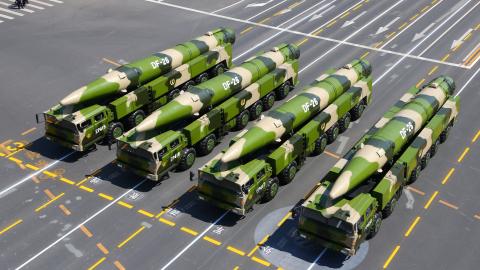The Albanese government’s Defence Strategic Review warns us we are witnessing a Chinese military build-up that is the largest and most ambitious by any country since the end of World War II. Beijing immediately accused Australia of misrepresenting its military modernisation as aggressive when it was defensive in nature, and using a “China threat” narrative as an excuse to start a regional arms race. According to China, it is Australia rather than China that is distressing neighbours by engaging in disruptive and destabilising behaviour.
Beijing’s dissembling and hypocrisy is easily exposed by simple facts. The People’s Liberation Army is regularly violating Taiwanese air and maritime territory and is openly threatening and preparing to take Taiwan by force. Chinese military and paramilitary vessels are routinely practising martial manoeuvres close to the Japanese-owned Senkaku Islands and in the South China Sea, which it claims as its own. China’s claims over virtually the entire sea as well as its militarised artificial islands have been found to have no basis in international law. By any reasonable understanding of timelines, Australia is hardly being provocative but is simply responding to Chinese aggression.
Moreover, Australia is not nearly as isolated as domestic and external critics of our more forward-leaning strategic and military posture tend to make out. But we have work to do. The maritime trading nations in East Asia will be decisive in determining the balance of power throughout the Indo-Pacific region over the next few decades. In maritime East Asia, Japan is rearming itself to remain the northern anchor of the alliance system led by the United States just as we are positioning as the southern anchor. Usually only concerned with affairs on the Korean Peninsula, Seoul is showing interest in closer co-operation with the Quad countries of the US, Japan, Australia, and India.
In strategic terms, it is China which remains a lonely and distrusted great power.
Even so, Beijing knows the soft heart or underbelly of maritime Asia remains Southeast Asia. It will have been alarmed by The Philippines recently offering American naval vessels access to four of its bases.
But more broadly, China’s grand plan to transform the Indo-Pacific into a Sino-centric or dominated region is heavily dependent on a submissive and defeatist Southeast Asia, and it has made significant strides in this regard. What China really doesn’t want are countries such as Australia and Japan showing smaller Southeast Asian states that resisting Chinese dominance is not just heroic and feasible, but a prudent and sensible thing to do.
Southeast Asia is the strategic centre and economic heart of the Indo-Pacific. This is clear from its maritime geography, as well as the flow of regional finance and structure of Asian supply and value chains. The key to easing out the US, and isolating countries such as Japan and Australia, is the relentless Chinese focus on changing, manipulating, or denying the capacity and/or resolve of especially Southeast Asian states to assist the US and its allies in maintaining and strengthening their role and presence in Asia.
In essence, the Chinese game plan is to simplify and reduce the complexity of the regional strategic map for itself. The more insipid and inactive states are in Southeast Asia, the better for China. Beijing’s ideal is that these small but critical maritime states remain weak, inward-focused, and on the sidelines.
It can then frame the strategic rivalry as one occurring only between a distant US and a small band of stubborn allies on the one hand, and the supposedly natural and permanent great Chinese power on the other.
There are cunning and effective Chinese approaches being implemented to bring about this outcome. While insisting that neutrality is their safest option, Beijing encourages them to focus on securing the guaranteed and immediate gains which come from submission rather than seek to compete with China. In policy terminology, these are known as “absolute gains”, which are benefits attained without regard to whether another entity is getting even more out of the bargain than oneself. In Chinese negotiations with Southeast Asian nations such as those occurring under the Belt and Road Initiative, China is invariably the greater beneficiary of any agreement. But smaller and less prosperous economies and their ruling elites are tempted by the immediate benefits on offer. Playing the long game, China emerges in a considerably enhanced position. The intended consequence is that these countries find themselves increasingly more reliant on Chinese acquiescence and largesse, and therefore less able to resist Chinese demands and coercion.
Another Chinese approach is to encourage Southeast Asian nations to focus only on economic growth rather than increasing other forms of material power, even if it is at the expense of their geostrategic and security interests. Many Southeast Asian nations have willingly or unwittingly done so. For example, strategically important countries such as Malaysia, The Philippines and Thailand have spent an average of about 1-1.5 per cent of gross domestic product each year on defence over the past decade. In 2022, the respective figure for these three countries were a dismal 0.96 per cent, 1 per cent and 1.16 per cent. Indonesia is even more abysmal, having spent less than 1 per cent of GDP each year on defence since 1998, with a 2022 figure of 0.7 per cent of GDP.
Among key Southeast Asian maritime states, only Singapore and Vietnam take defence seriously, with these two spending an average of about 4 – 5 percent and 2 – 2.5 per cent of GDP respectively each year during the past few decades. Despite its small size, only Singapore has managed to build up an inventory of modern weapons, while Vietnam is at least making good recent progress in this regard.
The continued withering of Southeast Asian strategic muscle memory and military ambition eliminates what ought to be a significant roadblock for a China seeking hegemony in East Asia. It also reduces opportunities for the US, Australia and other allies to work with these smaller nations to complicate matters for China.
For Southeast Asian nations themselves, the self-imposed lack of agency which comes from neglecting the realities of what China is doing weakens strategic creativity and courage. It leads them to internalise Chinese expansionism and assertiveness in addition to accepting and agreeing to unfair and unequal arrangements with Beijing. Chinese dominance becomes a self-fulfilling prophesy because if resistance is considered futile and too costly, then one does not resist but submit.
Australia should not be apologetic about AUKUS or the DSR, or play down the intent. They exist to not just prepare Australia for the worst but to convince other states that China can be deterred and constrained if enough countries are willing enough to pull their weight. Seeking to challenge a creeping regional assessment that Chinese success is inevitable, these are Australian initiatives and policies that are designed to disrupt regional complacency and help turn the tide.
Indeed, we need the Australian mindset to spread and for more countries to devote material resources to advancing and defending their interests against external threats. Contrary to longstanding diplomatic habit, we want our neighbours to rediscover martial attitudes and find new resolve to use blood and treasure to defend their core interests—as is occurring now in places such as Japan and Taiwan.
To be sure, one cannot assume a neighbour’s interests will always be aligned with ours, and it will be uncomfortable if they substantially increase their material and military power. But a more competitive and even rivalrous environment complicates things far more for an aggressive China than it does for Australia or our allies. And urging other countries to shake off their complacency is the prudent thing to do since the danger to the region is not alarmism or overreaction but the continued lack of urgency. It is to remind neighbours that sleepwalking our way to disaster is still disaster.

















